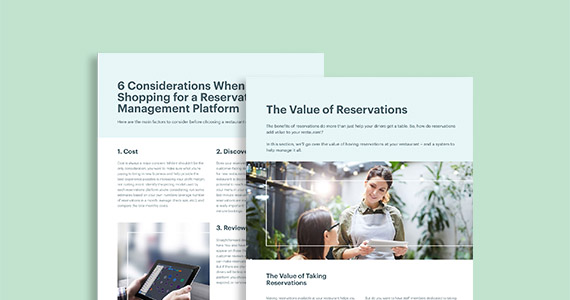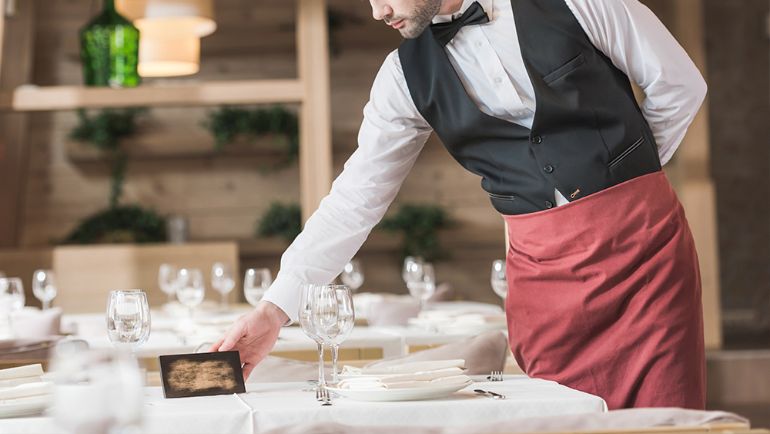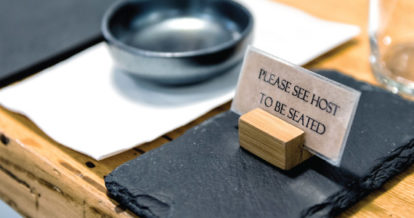At most full service restaurants, your customers usually have two options: make a reservation to secure a spot in advance or show up in hopes they’ll snag an open table.
For restaurant owners and managers, managing the mix between reservations and walk-ins can be challenging.
Done incorrectly, restaurant reservation management leads to frustrated customers, empty tables, and bleeding profits. Done well, customers are served faster and tables turned quicker, driving customer loyalty and revenues.
This article will give you some tips for successful restaurant reservation management by telling you about:
- The modern-day restaurant reservation process
- How to handle reservations during peak times
- How to gather feedback on the reservation process and implement changes
- How to train staff for a smooth reservation experience

Learn how a restaurant reservations system can help. your business thrive.
The Modern-day Restaurant Reservation Process
Technology, the internet, and mobile applications have revolutionized restaurant reservation management. But what people sometimes overlook is that they also play a huge role in improving operational efficiencies and the customer experience.
Here are some examples of reservation management systems:
- OpenTable
- Yelp Reservations
- Eveve
- Zomato Book
These tools have made reservation management a much smoother and seamless process for full service restaurants.
One step further than reservations, some apps also help with waitlist management. You can organize and filter reservations, text customers, and make the whole process of waiting in line a little less painful.
- OpenTable
- Waitlist Me (free version available)
- HostMe
- On Cue
Despite the increase in walk-ins, reservations are still common practice and appreciated by frequent diners. In fact, our recent Restaurant Insights report, How Diners Choose Restaurants, found that 45% of Generation X diners and 55% of Millennial diners say they make regular reservations, while 63% of urbanites always or usually make a reservation. Plus, OpenTable found that 36% of diners said online restaurant reservations are the most important technology feature for guests.
How to Handle Reservations during Peak Times
During a restaurant’s busiest hours, reservation management must be strategic – especially considering the average rate of no-shows for a typical restaurant is around 15%. Empty tables mean lost revenue. So how do you prevent that from happening?
Since most restaurants aren’t busy enough to rely solely on walk-ins, here are three tips to help optimize your reservation processes and effectively manage the mix of walk-ins and reservations. Use these tips to increase table turnover and keep your customers coming back.
1. Place time limits on reserved tables.
To avoid confusion or disappointment, it’s important to communicate clear policies with guests who are looking to book a reservation during peak business hours. You can ask guests to arrive on time or risk losing their table after 15 minutes.
2. Don’t reserve all of your tables.
Keep a couple of tables free during your busiest hours to avoid overbooking the dining room. Leaving a few tables unreserved means your regular guests who show up without notice will be pleasantly surprised with an available table.
You’ll also prevent the ultimate embarrassing situation: two reservations walk in at the same time, but only one of them has been recorded. Oops.
3. Implement OWL (On-Waiting-List) reservations.
A wait list is standard procedure for restaurants, but it can be hard to quote accurate wait times for guests. You can make this process more efficient by creating an On-Waiting-List (OWL) system for diners looking to book a reservation during your busiest hours.
Instead of turning diners down completely, an OWL reservation puts the guest’s name on the waiting list, and a table is set aside as close to their reservation time as possible. The guests may then have to wait 15-30 minutes even if they arrive at their preferred reservation time, but their wait time wouldn’t be as long as just a walk-in.

How to Gather Feedback on the Reservation Process
1. Customer and employee surveys
Soliciting feedback from customers is the best way to understand customer dining preferences. You should use surveys to help tailor your reservation process to better serve your guests.
Employees shouldn’t be disregarded here, either – after all, they are the eyes and ears of your business.
Customer satisfaction (CSAT) surveys are typically made up of questions used to determine how satisfied customers are with various areas of the business and to discover areas for improvement.
For example, include a link to a survey at the bottom of your receipts with a few short questions to measure their experience. Questions could include, “Did you make a reservation for lunch/dinner today?” and “How likely are you to refer us to a friend?” This data can be used to make correlations between the experience and satisfaction of diners who make reservations and diners who do not make reservations.
2. Online reviews and social media scraping
Online review sites and social media are one of the best ways to monitor what people are saying about your business, without having to request feedback.
Online comments about your business can be endless. To monitor and analyze the trends manually is often too time consuming. But there are many customer experience management platforms on the market that can help by using text analytics to identify emerging trends and key information, automatically alerting you when customers are talking about a specific issue, such as reservations.
3. Comment cards
If you aren’t ready to invest in software but still want to collect customer feedback, a comment card box is a good first step.
Ask customers to leave their email or phone numbers along with their comment. If you get a negative comment about how a customer had to wait 30 minutes for their reservation, you can follow up with a phone call and potentially a gift card for their next visit.
It may not be reasonable to give a gift card for every complaint, but that’s okay. You’d be surprised how far a simple phone call can go. Most of the time customers are just looking to be heard.

How to Train Staff for a Smooth Reservation Process
Front-of-house staff are crucial to your reservation process. Without the proper knowledge or training, your process may lead to errors and poor customer experiences. Follow these six tips to turn your front-of-house staff into reservation rock stars.
1. Create efficient processes for large reservations.
If you know your restaurant is busiest between 12:00 and 1:00 pm, it’s not a good idea to take large reservations that are going to clog up the dining room when you’re expecting walk-ins.
Larger parties take longer to serve, which means a large section of your dining room will be filled with the same group of people during your busiest hours – when you could have turned those tables over two or three times.
Train staff to communicate any policies on larger groups. For example, many restaurants don’t accept reservations for groups of eight or more during peak hours. This policy prevents guests from being disappointed with a less than pleasant, slow experience.
Another strategy is to train staff to take reservations for larger groups at specific times. For example, have your staff book larger groups at 11:30 am, so they can beat the lunch rush and avoid backing up the kitchen.
2. Educate staff to educate customers.
Teach staff how your restaurant functions at its best, so they can take that knowledge to customers. A smooth operation satisfies guests and creates a more memorable, pleasant experience.
For example, if a larger group comes in right before the lunch rush, your server should let those customers know they’ll get the best service possible if they place their orders before noon, when the kitchen is guaranteed to get slammed.
3. Stay organized.
Nothing will anger a customer more than having to wait when they have a firm reservation. You’re better off turning the customer down than making a promise you can’t keep. Organize your reservations in a single location, whether in a book or online system, to help avoid double booking or overbooking.
4. Assign designated reservation managers.
Don’t let everyone take reservations! Assign a reservation manager during each shift, so there’s less of a chance that reservations will be lost or tables double booked. That employee will know the processes and procedures for booking a reservation inside and out, keeping a close eye on what’s been scheduled.
5. Remind your guests of their reservation.
Sending an email confirmation or a reminder call a day before the reservation never hurts. It can reduce the chance of no-shows if they decide to cancel last minute. You can also use this point of contact to remind customers of your restaurant’s policies.
6. Don’t leave out the human element.
If you use a reservation system, don’t forget the power of good hospitality. Technology may help your restaurant from an operations and efficiency standpoint, but customers need to be treated as humans and not as a number in an online ordering system.
Whether you’re currently taking an active approach to collect customer feedback or not, customers are providing it. Find the techniques that will let you listen, take (most) of the feedback to heart, and use that knowledge to make better business decisions. But also make sure to involve staff in your restaurant reservation management – an effort that will translate into full tables, satisfied customers, and better customer experiences.
Free Restaurant Cleaning Checklist
Sign up for our free weekly TouchBistro Newsletter







